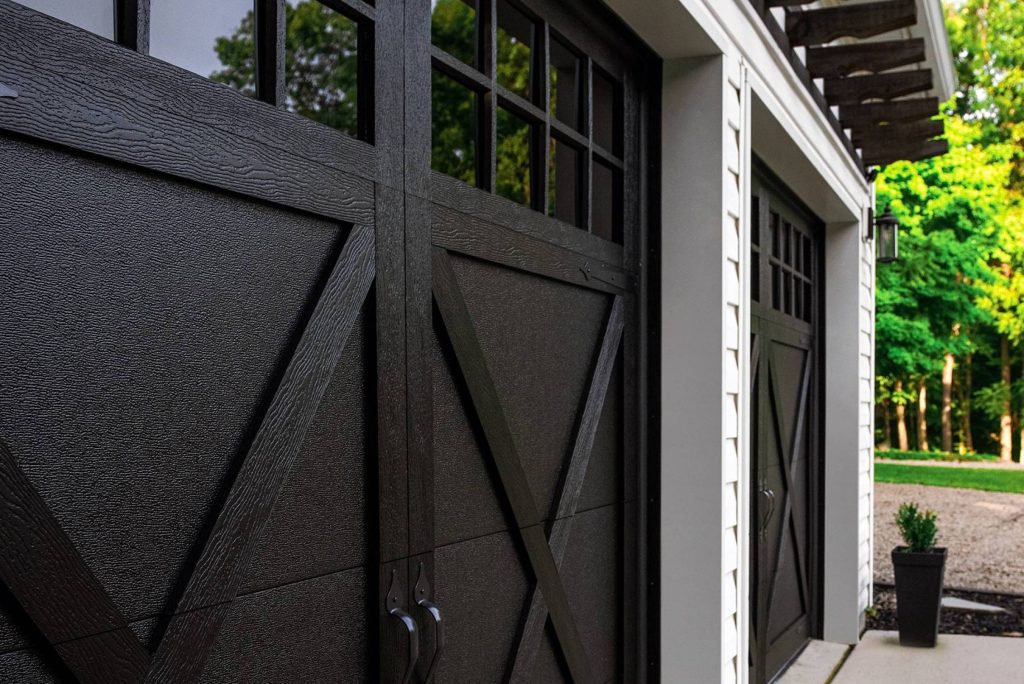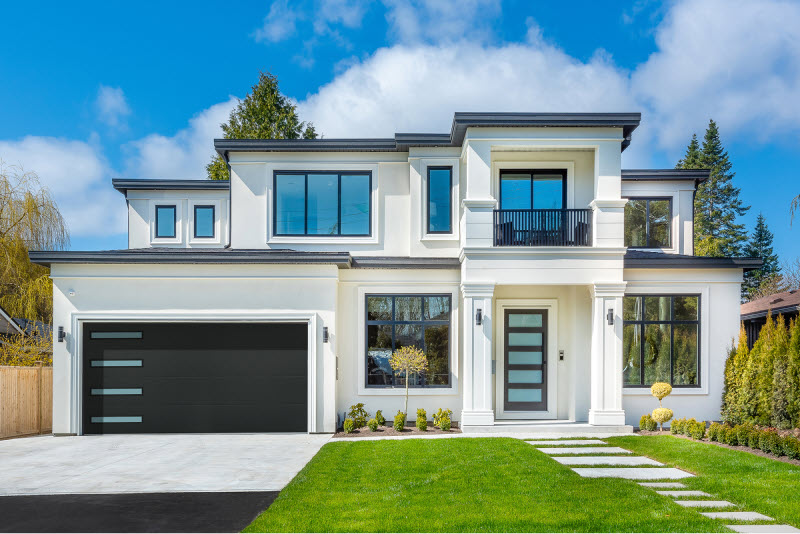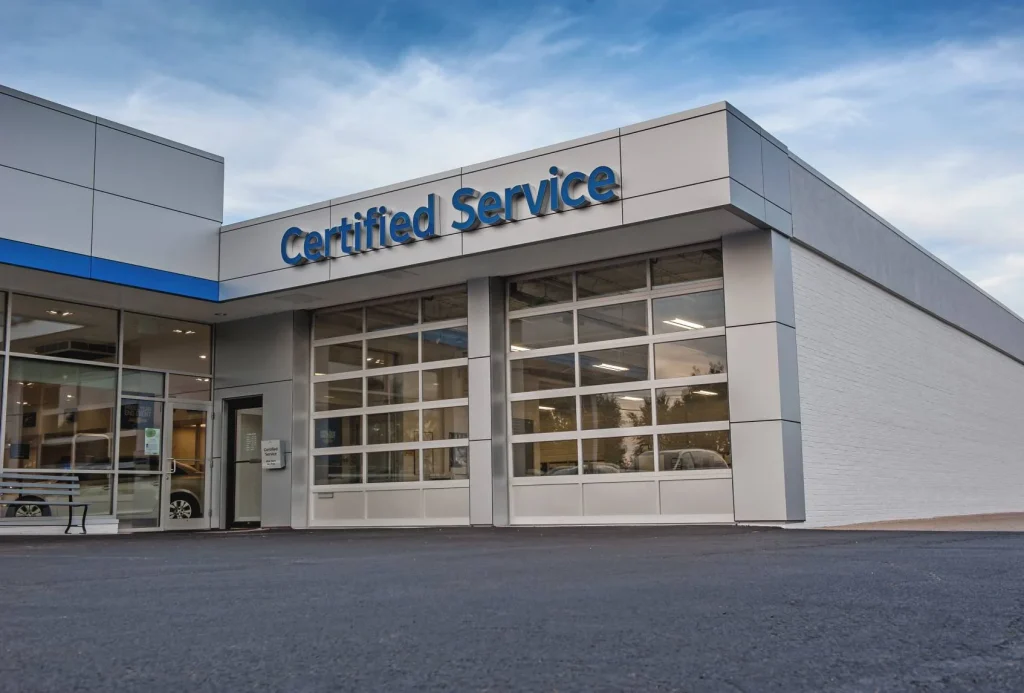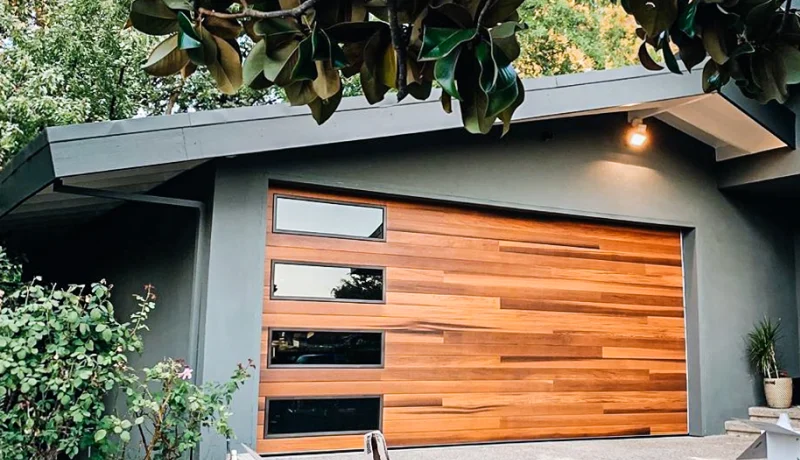Insulated Garage Doors in Dearborn, MI
Energy-Efficient Doors for Superior Temperature Control
Locally Owned & Operated Since 2017
Schedule A Service Request
We Serve Businesses In And Around The Following Cities:
About Insulated Garage Doors
Insulated Garage Doors: The Key to Efficient and Reliable Overhead Garage Solutions in Dearborn, Michigan
Understanding the Importance of Insulated Garage Doors
In the realm of home and business improvement, insulated garage doors have emerged as indispensable components in ensuring thermal efficiency, energy conservation, and enhanced durability. Particularly in the vibrant community of Dearborn, Michigan, where climate conditions can oscillate from cold winters to warm summers, the need for an insulated garage door cannot be overstated. The expertise of McClellan Overhead Door in providing comprehensive services related to overhead garage door repair and installation further highlights the increasing demand for quality and performance.
The appeal of insulated doors for garages extends beyond mere temperature regulation. These doors are crucial in safeguarding your assets, maintaining energy efficiency, and enhancing the aesthetic appeal of your property. With their double-layered construction, insulated garage doors offer superior thermal resistance and are less likely to warp, crack, or suffer from wear and tear common in non-insulated options. This distinct advantage makes them an invaluable investment for both residential and commercial properties.
Insulated Garage Doors: A Deep Dive into their Construction and Benefits
The foundation of an insulated garage door is its construction, typically comprising multiple layers of material that work in tandem to deliver ultimate performance. Double-layer insulated doors are particularly renowned for their robustness and efficiency; these doors consist of a layer of insulating material, often polystyrene or polyurethane, sandwiched between two layers of steel or other durable materials. This layer not only insulates but also provides substantial soundproofing, making it a suitable choice for properties located in bustling areas.
Energy-efficient garage doors are instrumental in minimizing energy loss, thus contributing to reduced utility costs. The thermal properties of insulated steel garage doors keep interiors warm during winters and cool during summers, proving highly valuable in a climate as variable as that of Dearborn, Michigan. Over time, this investment pays dividends by significantly reducing the strain on your heating and cooling systems.
Moreover, the construction of thermal garage doors often incorporates weatherproof seals that prevent water, dust, and debris infiltration. This weatherproofing is particularly crucial in areas prone to heavy rainfalls or snow, offering an additional layer of protection and prolonging the life of the garage door system. The comprehensive services offered by McClellan Overhead Door ensure that installation is carried out with precision, guaranteeing optimal performance and longevity of your investment.
The Installation Process: What to Expect When You Choose McClellan Overhead Door
Opting for an insulated garage door installation in Dearborn, Michigan is a decision laden with multiple beneficial outcomes. From a structural perspective, this involves a meticulous process that only seasoned professionals like those at McClellan Overhead Door can deliver. The installation begins with a detailed assessment of the property; professionals take measurements, evaluate the garage layout, and select the insulated door that best meets the specific demands of the client.
Following the initial consultation, the focus shifts to the installation itself. The old garage door is removed carefully, minimizing disruption and ensuring the safety of surrounding structures and vehicles. The new insulated steel garage doors are then fitted with precision, reinforced with thermal seals and hardware tailored to enhance energy efficiency and security. This methodical approach minimizes common issues such as improper fitting or misalignment, which can jeopardize the door’s longevity and performance.
McClellan Overhead Door is renowned for their commitment to excellence in installation and repair services. Engaging these experts ensures a seamless installation process, leaving clients with a robust, energy-efficient garage door tailored to withstand the rigors of Michigan’s diverse climate.
Benefits of Insulated Garage Doors for Residential Properties
Residential properties substantially benefit from the installation of insulated garage doors, thanks to the myriad of advantages they usher in. The most apparent benefit is thermal efficiency; well-insulated doors stabilize indoor temperatures, reducing reliance on expensive heating and cooling systems throughout the year. This is particularly instrumental during the harsh winter months often experienced in Dearborn, Michigan.
Additionally, homeowners can appreciate a noticeable decrease in noise pollution. The dense construction of insulated garage doors effectively dampens external sounds, a considerable advantage for those living near busy roads or industrial areas. Further, these doors contribute to a heightened security profile of your home. Being thicker and more robust than basic models, they act as a formidable deterrent against break-ins, safeguarding both property and peace of mind.
Finally, the aesthetic appeal of energy-efficient garage doors cannot be understated. Available in a range of styles and finishes, they elevate the curb appeal of any home, seamlessly blending functionality with design. The benefits are clear; not only do these doors pay for themselves over time, but they also significantly increase the market value of your residential property.
Commercial Applications of Insulated Garage Doors
For businesses operating in Dearborn, insulated garage doors offer a plethora of benefits that extend beyond mere temperature control. These doors play a pivotal role in ensuring the seamless operation of business activities by offering superior workmanship and durability. In commercial settings, where garage doors often see frequent use, the need for durability and reliability becomes paramount.
Thermal garage doors help regulate temperature-sensitive environments, which is crucial for businesses that store perishable goods. The ability to maintain consistent temperatures helps in protecting inventory and reducing energy expenditure, thereby boosting overall efficiency. Furthermore, the weatherproof nature of these doors ensures protection from elements, reducing potential damage from inclement weather.
Security is another critical concern for commercial properties. Insulated steel garage doors are more resistant to forced entry, offering an added layer of protection for assets. When it comes to repair or replacement, the expertise of McClellan Overhead Door ensures minimal downtime, keeping business operations running smoothly.
Practical Considerations for Choosing the Right Insulated Garage Door
Selecting the right insulated garage door involves balancing aesthetics, functionality, and budget. Factors such as material selection, insulation rating, and custom features play a critical role in determining the ultimate choice. Businesses and homeowners in Dearborn, Michigan can leverage the expertise of McClellan Overhead Door to navigate these decisions effectively.
The R-value is an essential metric in this context. It indicates the thermal resistance offered by the door, with higher values signifying better insulation. McClellan Overhead Door can guide clients in selecting a door with an appropriate R-value that aligns with energy-saving goals and budgetary constraints. Furthermore, considering the garage door's operational environment is imperative; areas prone to harsh weather conditions require robust and weatherproof solutions.
Custom features, such as windows or specialized finishes, can also be integrated into the design of insulated garage doors to enhance appeal and functionality. McClellan Overhead Door specializes in tailoring solutions to meet the precise needs and preferences of clients, ensuring satisfaction in both performance and design.
Maintenance and Repair: Keeping Your Insulated Garage Door in Optimal Condition
Regular maintenance is crucial in extending the life and performance of insulated garage doors. Given the variable weather conditions in Dearborn, consistent maintenance efforts are necessary to address potential wear and tear, ensuring that the doors remain in pristine condition and continue to perform efficiently.
Professional maintenance services, such as those offered by McClellan Overhead Door, include comprehensive inspections to identify potential issues, lubrication of moving components, and adjustments to the door’s balance and alignment. Preventative maintenance helps avoid sudden malfunctions and costly repairs, keeping the garage door system running smoothly.
When repairs are needed, the expertise of McClellan Overhead Door ensures quick resolutions. Whether it’s a malfunctioning opener, damaged panels, or compromised seals, professional technicians can address issues promptly, restoring functionality and security. Their commitment to providing reliable repair services ensures that clients can rest assured knowing their garage doors are in capable hands.
In conclusion, insulated garage doors offer a wealth of benefits for both residential and commercial properties. From improving energy efficiency and security to enhancing property aesthetics, they are an invaluable addition to any property in Dearborn, Michigan. By choosing McClellan Overhead Door for installation and repair services, property owners can ensure they are receiving a quality product backed by expert service. Whether you’re looking to upgrade an existing garage or install a new system, the transformative potential of insulated garage doors cannot be understated. Your decision to invest in them will resonate positively for years, securing great value from enhanced functionality, design, and savings on energy consumption. With professionals handling your installation and maintenance needs, you can confidently rely on this critical home improvement to deliver tangible benefits.
Insulated Garage Doors Gallery



Call Us Today to receive your Free Quote for Insulated Garage Doors in Dearborn
Serving: Dearborn, Michigan

About Dearborn, Michigan
Before European encounter, the area had been inhabited for thousands of years by successive First Nations peoples. Historical tribes belonged mostly to the Algonquian-language family, especially the Council of Three Fires, the Potawatomi and related peoples. In contrast, the Huron (Wyandot) were Iroquoian speaking. French colonists had a trading post at Fort Detroit and a settlement developed there in the colonial period. Another developed on the south side of the Detroit River in what is now southwestern Ontario, near a Huron mission village. French and French-Canadian colonists also established farms at Dearborn in this period. France ceded all of its territory east of the Mississippi River in North America to Great Britain in 1763 after losing to Britain in the Seven Years' War.
Beginning in 1786, after the United States gained independence in the American Revolutionary War, more European Americans entered this region, settling in Detroit and the Dearborn area. With population growth, Dearborn Township was formed in 1833 and the village of Dearbornville in 1836, each named after Henry Dearborn, a general in the American Revolution who became Secretary of War under President Thomas Jefferson. The Town of Dearborn was incorporated in 1893. Through much of the 19th century, the area was largely rural and dependent on agriculture.
Stimulated by industrial development in Detroit and within its own limits, in 1927 Dearborn was established as a city. Its current borders result from a 1928 consolidation vote that merged Dearborn and neighboring Fordson (previously known as Springwells), which feared being absorbed into expanding Detroit.
According to historian James W. Loewen, in his book Sundown Towns (2005), Dearborn discouraged African Americans from settling in the city. In the early 20th century, both white and black people migrated to Detroit for industrial jobs. Over time, some city residents relocated in the suburbs. Many of Dearborn's residents "took pride in the saying, 'The sun never set on a Negro in Dearborn'". According to Orville Hubbard, the segregationist mayor of Dearborn from 1942 to 1978, "as far as he was concerned, it was against the law for a Negro to live in his suburb." Hubbard told the Montgomery Advertiser in the mid-1950s, "Negroes can't get in here. Every time we hear of a Negro moving in, we respond quicker than you do to a fire."
The area between Dearborn and Fordson was undeveloped, and remains so in part. Once farm land, much of this property was bought by Henry Ford for his estate, Fair Lane, and for the Ford Motor Company World Headquarters. Later developments in this corridor were the Ford airport (later converted to the Dearborn Proving Grounds), and other Ford administrative and development facilities.
More recent additions are The Henry Ford (a reconstructed historic village and museum), the Henry Ford Centennial Library, the super-regional shopping mall Fairlane Town Center, and the Ford Performing Arts Center. The open land is planted with sunflowers and often with Ford's favorite crop of soybeans. The crops are never harvested.
The Arab American National Museum (AANM) opened in 2005, the first museum in the world devoted to Arab American history and culture. Arab Americans in Dearborn include descendants of Lebanese Christians who immigrated in the early twentieth century to work in the auto industry, and more recent Arab immigrants and their descendants from other, primarily Muslim nations.
On February 2, 2024, the Wall Street Journal published an opinion piece titled "Welcome to Dearborn, America's Jihad Capital", claiming that there were a large number of supporters of Islamic extremism in the area. Mayor Abdullah Hammoud said the article was inflammatory and was responsible for increased online hate speech against the city's citizens, so he increased police patrols.
According to the United States Census Bureau, the city has a total area of 24.5 square miles (63 km), of which 24.4 square miles (63 km) is land and 0.1 square miles (0.26 km) (0.37%) is water. The city developed on both sides of the Rouge River. An artificial waterfall/low head dam was constructed by Henry Ford on his estate to power its powerhouse. The Upper, Middle, and Lower Branches of the river come together in Dearborn. The river is widened and channeled near the Rouge Plant to allow lake freighter access.
Fordson Island (42°17′38″N 83°08′52″W / 42.29389°N 83.14778°W / 42.29389; -83.14778) is an 8.4 acres (3.4 hectares) island about three miles (5 km) upriver on the River Rouge from its confluence with the Detroit River. It is the only major island in a tributary to the Detroit River. It was created in 1922 when engineers dug a secondary trench to reroute the River Rouge to increase navigability for shipping purposes, and businesses needed it to be navigable by the large lake freighters. The island is privately owned, has no public access, and is part of the city of Dearborn which has no frontage along the Detroit River.
Dearborn is among a small number of municipalities that own property in other cities. It owns the 626-acre (2.53 km) Camp Dearborn in Milford, Michigan, which is located 35 miles (56 km) from Dearborn. Dearborn was among an even smaller number of cities that hold property in another state. For a time, the city owned the Dearborn Towers apartment complex in Clearwater, Florida, but this has been sold. Camp Dearborn is considered part of the city of Dearborn. Revenues generated by camp admissions are incorporated into the city's budget.
| Census | Pop. | Note | %± |
|---|---|---|---|
| 1860 | 355 | — | |
| 1870 | 530 | 49.3% | |
| 1880 | 410 | −22.6% | |
| 1900 | 844 | — | |
| 1910 | 911 | 7.9% | |
| 1920 | 2,470 | 171.1% | |
| 1930 | 50,358 | 1,938.8% | |
| 1940 | 63,589 | 26.3% | |
| 1950 | 94,994 | 49.4% | |
| 1960 | 112,007 | 17.9% | |
| 1970 | 104,199 | −7.0% | |
| 1980 | 90,660 | −13.0% | |
| 1990 | 89,286 | −1.5% | |
| 2000 | 97,775 | 9.5% | |
| 2010 | 98,153 | 0.4% | |
| 2020 | 109,976 | 12.0% | |
| U.S. Decennial Census 2018 Estimate | |||
This section needs expansion with: examples with reliable citations. You can help by adding to it. (September 2021) |
| Race / ethnicity | Pop. 2000 | Pop. 2010 | Pop. 2020 | % 2000 | % 2010 | % 2020 |
|---|---|---|---|---|---|---|
| White alone (NH) | 82,893 | 85,116 | 93,884 | 84.78% | 86.72% | 85.37% |
| Black or African American alone (NH) | 1,225 | 3,895 | 4,346 | 1.25% | 3.97% | 3.95% |
| Native American or Alaska Native alone (NH) | 214 | 166 | 107 | 0.22% | 0.17% | 0.10% |
| Asian alone (NH) | 1,431 | 1,696 | 2,783 | 1.46% | 1.73% | 2.53% |
| Pacific Islander alone (NH) | 13 | 31 | 16 | 0.01% | 0.03% | 0.01% |
| Other race alone (NH) | 124 | 171 | 549 | 0.13% | 0.17% | 0.50% |
| Mixed race or multiracial (NH) | 8,944 | 3,692 | 4,351 | 9.15% | 3.76% | 3.96% |
| Hispanic or Latino (any race) | 2,931 | 3,386 | 3,940 | 3.00% | 3.45% | 3.58% |
| Total | 97,775 | 98,153 | 109,976 | 100.00% | 100.00% | 100.00% |
As of the 2010 census, the population of Dearborn was 98,153. The racial and ethnic composition was 89.1% White, 4.0% black or African-American, 0.2% Native American, 1.7% Asian, 0.2% Non-Hispanic of some other race, 4.0% reporting two or more races and 3.4% Hispanic or Latino. 41.7% were of Arab ancestry (categorized as "White" in Census collection data).
In the 2000 census, 61.9% spoke only English at home, 29.3% spoke Arabic, 1.9% Spanish, and 1.5% Polish. There were 36,770 households, out of which 31.3% had children under the age of 18 living with them, 51.0% were married couples living together, 9.4% had a female householder with no husband present, and 35.1% were non-families. 30.9% of all households were made up of individuals, and 14.7% had someone living alone who was 65 years of age or older. The average household size was 2.65 and the average family size was 3.42.
In the city, 27.8% of the population was under the age of 18, 8.3% was from 18 to 24, 29.2% from 25 to 44, 19.1% from 45 to 64, and 15.6% was 65 years of age or older. The median age was 34 years. For every 100 females, there were 99.0 males. For every 100 females age 18 and over, there were 96.5 males.
The median income for a household in the city was $44,560, and the median income for a family was $53,060. Males had a median income of $45,114 versus $33,872 for females. The per capita income for the city was $21,488. About 12.2% of families and 16.1% of the population were below the poverty line, including 24.4% of those under age 18 and 7.6% of those age 65 and over.
As of the 2012 estimate, Dearborn's population was thought to have fallen to 96,474, a decrease of 1.7% since 2010. Over the same period, though, SEMCOG, the local statistics agency of Metro Detroit Council of Governments, has estimated the city to have grown to 99,001, or an increase of 1.2% since 2000. SEMCOG's July 2014 estimate listed Dearborn with a population of 102,566.
Dearborn has a large community of descendants of ethnic Europeans who arrived as immigrants from the mid-19th into the 20th centuries. Their ancestors generally first settled in Detroit: Irish, German, Italians, and Polish. It is also a center of Maltese American settlement, from the Mediterranean island of Malta. Also attracted to jobs in the auto industry, some were among immigrant Maltese who first settled in Corktown.
The city has a small African-American population, many of whose ancestors came to the area from the rural South during the Great Migration of the early twentieth century.
The city's population includes 40,000 Arab Americans. Per the 2000 census, Arab Americans totaled 29,181 or 29.85% of Dearborn's population; many are descendants of families who have been in the city since the early 20th century. The city has the largest proportion of Arab Americans in the United States. As of 2006 Dearborn has the largest Lebanese American population in the United States.
The first Arab immigrants came in the early-to-mid-20th century to work in the automotive industry and were chiefly Lebanese Christians (Maronites). Other immigrants from the Middle East, such as Assyrians, have also immigrated to the area. Since then, Arab immigrants from Yemen, Iraq and the Palestinian territories, most of whom are Muslim, have joined them. Lebanese Americans comprise the largest group of ethnic Arabs. The Arab Muslim community has built the Islamic Center of America, the largest mosque in North America, and the Dearborn Mosque. More Iraqi refugees have come, fleeing the continued war in their country since 2003.
Warren Avenue has become the commercial center of the Arab-American community. The Arab American National Museum is located in Dearborn. The museum was opened in January 2005 to celebrate the Arab American community's history, culture and contributions to the United States.
In the 2019 U.S. Census estimates, the largest ethnic group were Lebanese Americans, and the second largest were Yemeni Americans.
In 2010, Nabeel Qureshi, David Wood, and two other people acting as Christian missionaries, were arrested at the Dearborn International Arab Festival. They had been handing out Christian literature aimed at Muslim believers. The four were prosecuted for breach of the peace. Police ordered them to stop filming the incident, to provide identification, and to move at least five blocks from the border of the fair. After reviewing the video evidence, the jury acquitted the defendants. The four defendants filed a separate civil suit against the city. Dearborn was found to have violated their constitutional rights related to freedom of speech. The city settled the lawsuit and issued a formal apology to the individuals.
Sharron Angle, a Republican senatorial candidate in Nevada, said in an October 2010 political speech that the Arab Americans in Dearborn contributed to a "militant terrorist situation," and that the city government was enforcing Islamic sharia law. Mayor Jack O'Reilly strongly criticized Angle, saying, "She took it as face value and maligned the city of Dearborn and I consider that totally irresponsible".
Preacher Terry Jones of Gainesville, Florida, known for burning a Quran, the sacred book of Islam, planned a protest in 2011 outside the Islamic Center of America. Local authorities required him either to post a $45,000 "peace bond" to cover Dearborn's cost if Jones incited violence, or to go to trial. Jones contested that requirement, and he and his co-pastor Wayne Sapp refused to post the bond. They were held briefly in jail, while claiming violation of First Amendment rights. That night Jones was released by the court. The ACLU had filed an amicus brief in support of Jones's protest plans. One week later, on April 29, Jones led a rally at the Dearborn City Hall, in a designated free speech zone. Riot police were called out to control counter protesters. Jones also planned to speak at the annual Arab Festival on June 18, 2011, but his route was blocked by protesters, six of whom were arrested. Police said they did not have enough officers present to maintain safety. Christian missionaries accompanied Jones with their own protest signs.
On November 11, 2011, Wayne County Circuit Court Judge Robert Ziolkowski vacated the "breach of peace" ruling against Jones and Sapp on the grounds that they were denied due process. On April 7, 2012, Jones led another protest in front of the Islamic Center of America, where he spoke about Islam and free speech. The mosque officials had locked it down to prevent damage. The city used thirty police cars to block traffic from the area in an effort to prevent a counter protest.
Dearborn has a mayor-council form of government. As of 2021, the Mayor of the City of Dearborn is Abdullah Hammoud. The City Clerk is George T. Darany. The City Council President is Michael T. Sareini.
Built in 1922, the Dearborn City Hall Complex was in operation until 2014 when government operations moved to the new Dearborn Administrative Center. The former city hall was redeveloped by Artspace Projects to preserve affordable and sustainable space for artists and arts organizations.
University of Michigan–Dearborn and Henry Ford College are located in Dearborn on Evergreen Road and are adjacent to each other. Concordia University Dearborn Center and Central Michigan University offer classes in Dearborn. Career training schools include Kaplan Career Institute and Sanford Brown College.
Dearborn residents, along with a small portion of Dearborn Heights residents, attend Dearborn Public Schools. The system operates 34 schools, including the major high schools Fordson High School, Dearborn High School, and Edsel Ford High School. The public schools serve more than 18,000 students in the fourth-largest district in the state.
Divine Child High School and Elementary School are private schools in Dearborn; the high school is the largest private coed high school in the area. Henry Ford Academy is a charter high school inside Greenfield Village and the Henry Ford Museum. Another charter secondary school is Advanced Technology Academy. Dearborn Schools operated the Clara B. Ford High School inside Vista Maria, a non-profit residential treatment agency for girls in Dearborn Heights. Clara B. Ford High School became a charter school in the 2007–08 school year.
A small portion of the city limits is within the Westwood Community School District. The sections of Dearborn within the district are zoned for industrial and commercial uses.
The Islamic Center of America operates the Muslim American Youth Academy (MAYA), an Islamic elementary and middle school.
The Roman Catholic Archdiocese of Detroit operates Sacred Heart Elementary School. It previously operated the St. Alphonsus School in Dearborn. In 2003 the archdiocese closed the high school of St. Alphonsus, and in 2005 closed the St. Alphonsus elementary school.
Global Educational Excellence operates multiple charter schools in Dearborn: Riverside Academy Early Childhood Center, Riverside Academy East Campus (K-5), and Riverside Academy West Campus (6–12).
Dearborn Christian School closed in 2014.
Dearborn Public Library includes the Henry Ford Centennial Library, which is the main library; and the Bryant and Esper branches.
Dearborn's first public library opened in 1924 at the building now known as the Bryant Branch. This served as the main library until the Ford library opened in 1969. In 1970 what became known as the Mason building was classified as a branch library. The library was renamed in 1977 after Katharine Wright Bryant, who developed a plan for the library and campaigned for it.
Around April 1963 the Ford Motor Company granted the City of Dearborn $3 million to build a library as a memorial to Henry Ford. The company deeded 15.3 acres (6.2 ha) of vacant land for the public library to the city on July 30, 1963, the centennial or 100th anniversary of Henry Ford's birth. The Ford Foundation later granted the library an additional $500,000 for supplies and equipment. On November 25, 1969, the library was dedicated. Originally only the library had offices in the building but in 1979, the library gave up the western side's meeting rooms for the City of Dearborn Health Department.
The Esper Branch, the smallest branch, is located in what is known as the Arab residential quarter of the city, dedicated on October 12, 1953. Originally named the Warren Branch, this structure had replaced the Northeast Branch, which opened in a storefront in 1944. In October 1961, it was named after city councilman Anthony M. Esper.
During the years 1934 to 1943, during and after the Great Depression, murals were commissioned for federal public buildings in the United States through the Section of Painting and Sculpture, later called the Section of Fine Arts, of the Treasury Department. They often featured representation of local history. In 1938 artist Rainey Bennett painted an oil-on-canvas mural for the federal post offices in Dearborn titled Ten Eyck's Tavern on Chicago Road.
Sports facilities include the Dearborn Ice Skating Center and the Dearborn Civic Center.
Amtrak, the national passenger rail system, provides service to Dearborn, operating its Wolverine three times daily in each direction between Chicago, Illinois and Pontiac, via Detroit. Baggage cannot be checked at this location; however, up to two suitcases, in addition to any "personal items" such as briefcases, purses, laptop bags, and infant equipment, are allowed on board as carry-ons. There is one rail stop in Dearborn: the John D. Dingell Transit Center. Amtrak operates on the Michigan Department of Transportation Michigan Line. This track runs from Dearborn to Kalamazoo, Michigan. CSX Transportation's Detroit Subdivision, Canadian National Railway/Grand Trunk Western Railroad's Dearborn Subdivision, and Conrail Shared Assets' Junction Yard Running Track also pass through Dearborn. Most of the freight traffic on these rails is related to the automotive industry.
Dearborn is served by buses of both the Detroit Department of Transportation (DDOT) and the Suburban Mobility Authority for Regional Transportation (SMART) systems.
From 1924 to 1947, Dearborn was the site of Ford Airport. It featured the world's first concrete runway and the first scheduled U.S. passenger service.
Launched in March 2021, SMART Flex is an on-demand public transit service launched in partnership with TransitTech company Via Transportation. SMART Flex is available to residents and workers in Dearborn, Troy, the Hall Road corridor between Utica and New Baltimore, Pontiac/Auburn Hills, and Farmington/Farmington Hills to book rides using the SMART Flex app.
